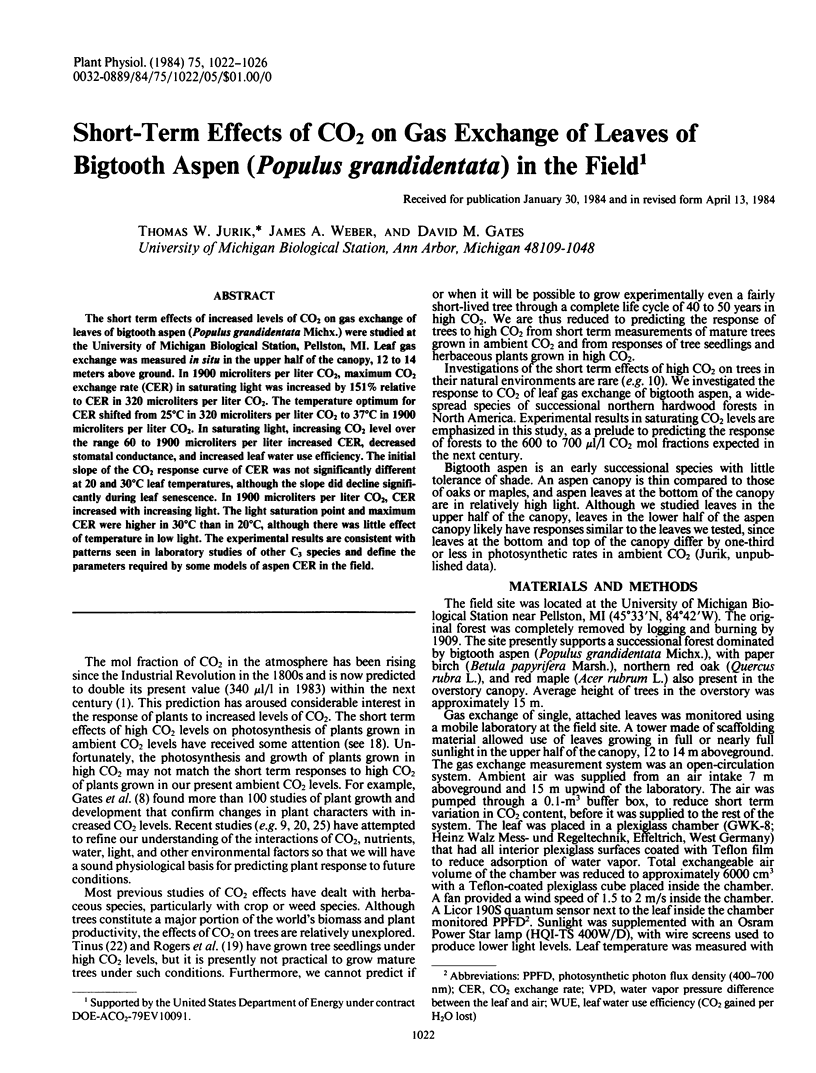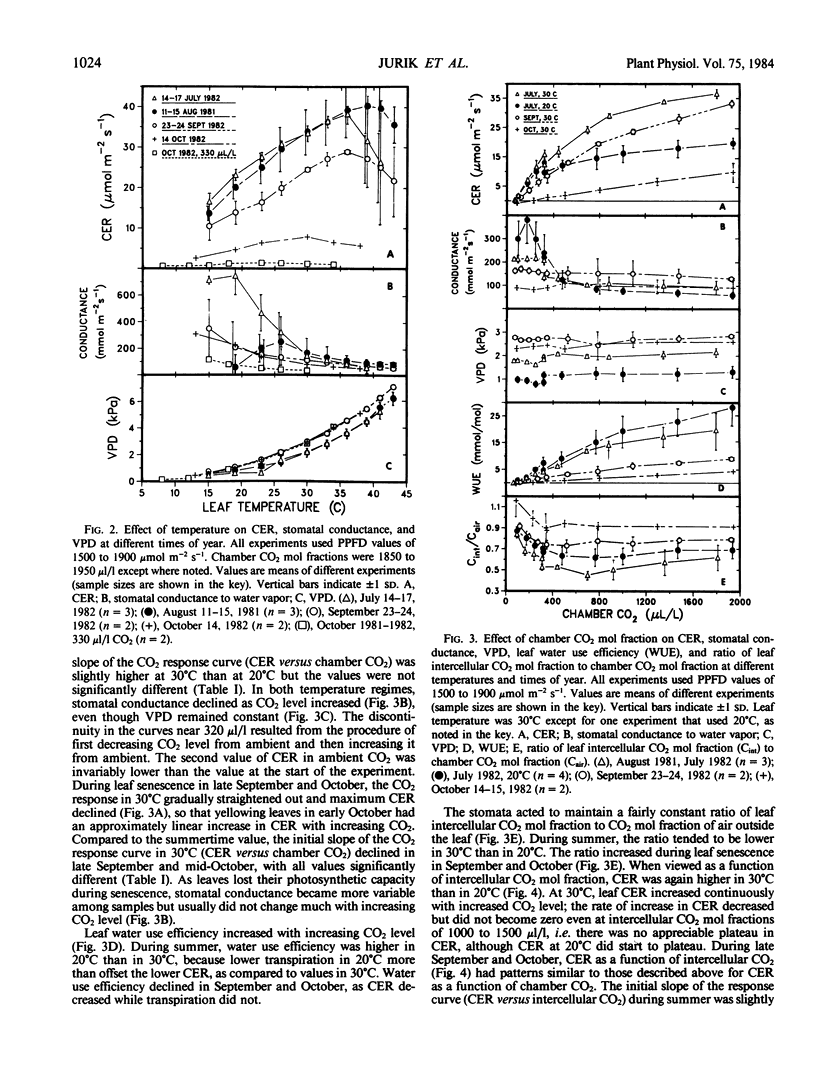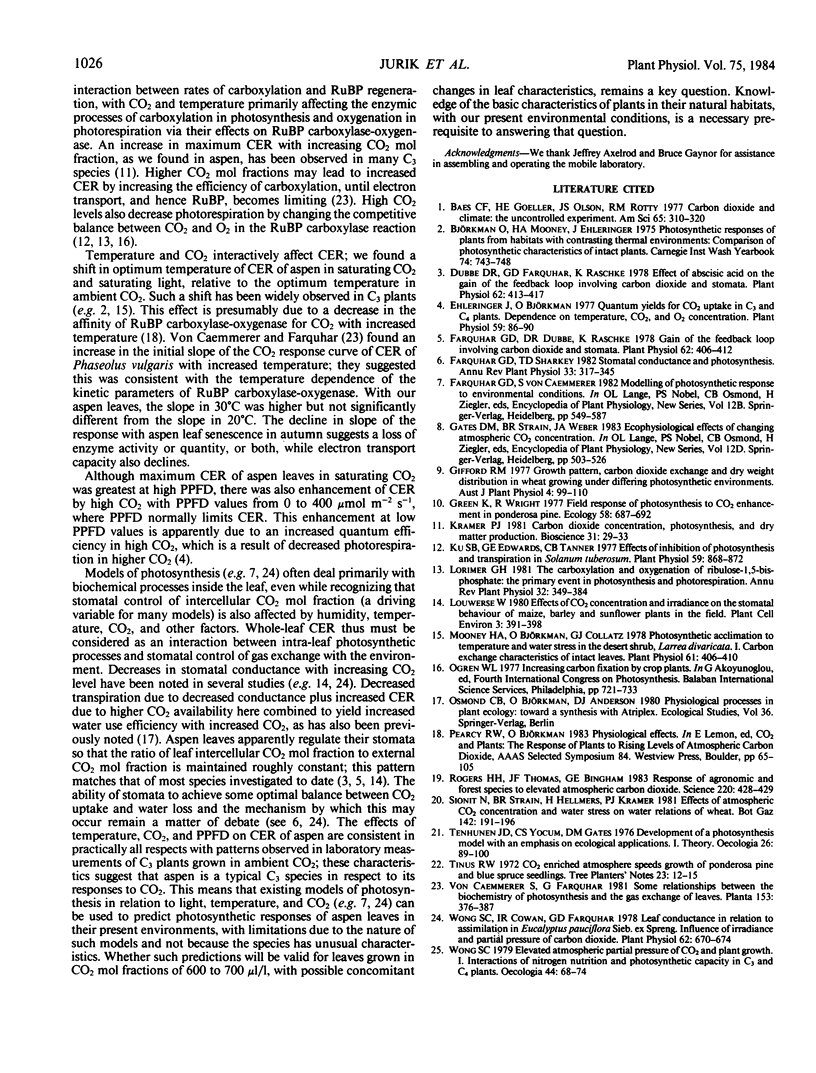Abstract
The short term effects of increased levels of CO2 on gas exchange of leaves of bigtooth aspen (Populus grandidentata Michx.) were studied at the University of Michigan Biological Station, Pellston, MI. Leaf gas exchange was measured in situ in the upper half of the canopy, 12 to 14 meters above ground. In 1900 microliters per liter CO2, maximum CO2 exchange rate (CER) in saturating light was increased by 151% relative to CER in 320 microliters per liter CO2. The temperature optimum for CER shifted from 25°C in 320 microliters per liter CO2 to 37°C in 1900 microliters per liter CO2. In saturating light, increasing CO2 level over the range 60 to 1900 microliters per liter increased CER, decreased stomatal conductance, and increased leaf water use efficiency. The initial slope of the CO2 response curve of CER was not significantly different at 20 and 30°C leaf temperatures, although the slope did decline significantly during leaf senescence. In 1900 microliters per liter CO2, CER increased with increasing light. The light saturation point and maximum CER were higher in 30°C than in 20°C, although there was little effect of temperature in low light. The experimental results are consistent with patterns seen in laboratory studies of other C3 species and define the parameters required by some models of aspen CER in the field.
Full text
PDF




Selected References
These references are in PubMed. This may not be the complete list of references from this article.
- Dubbe D. R., Farquhar G. D., Raschke K. Effect of abscisic Acid on the gain of the feedback loop involving carbon dioxide and stomata. Plant Physiol. 1978 Sep;62(3):413–417. doi: 10.1104/pp.62.3.413. [DOI] [PMC free article] [PubMed] [Google Scholar]
- Ehleringer J., Björkman O. Quantum Yields for CO(2) Uptake in C(3) and C(4) Plants: Dependence on Temperature, CO(2), and O(2) Concentration. Plant Physiol. 1977 Jan;59(1):86–90. doi: 10.1104/pp.59.1.86. [DOI] [PMC free article] [PubMed] [Google Scholar]
- Farquhar G. D., Dubbe D. R., Raschke K. Gain of the feedback loop involving carbon dioxide and stomata: theory and measurement. Plant Physiol. 1978 Sep;62(3):406–412. doi: 10.1104/pp.62.3.406. [DOI] [PMC free article] [PubMed] [Google Scholar]
- Ku S. B., Edwards G. E., Tanner C. B. Effects of Light, Carbon Dioxide, and Temperature on Photosynthesis, Oxygen Inhibition of Photosynthesis, and Transpiration in Solanum tuberosum. Plant Physiol. 1977 May;59(5):868–872. doi: 10.1104/pp.59.5.868. [DOI] [PMC free article] [PubMed] [Google Scholar]
- Mooney H. A., Björkman O., Collatz G. J. Photosynthetic Acclimation to Temperature in the Desert Shrub, Larrea divaricata: I. Carbon Dioxide Exchange Characteristics of Intact Leaves. Plant Physiol. 1978 Mar;61(3):406–410. doi: 10.1104/pp.61.3.406. [DOI] [PMC free article] [PubMed] [Google Scholar]
- Rogers H. H., Thomas J. F., Bingham G. E. Response of agronomic and forest species to elevated atmospheric carbon dioxide. Science. 1983 Apr 22;220(4595):428–429. doi: 10.1126/science.220.4595.428. [DOI] [PubMed] [Google Scholar]
- Wong S. C., Cowan I. R., Farquhar G. D. Leaf Conductance in Relation to Assimilation in Eucalyptus pauciflora Sieb. ex Spreng: Influence of Irradiance and Partial Pressure of Carbon Dioxide. Plant Physiol. 1978 Oct;62(4):670–674. doi: 10.1104/pp.62.4.670. [DOI] [PMC free article] [PubMed] [Google Scholar]


